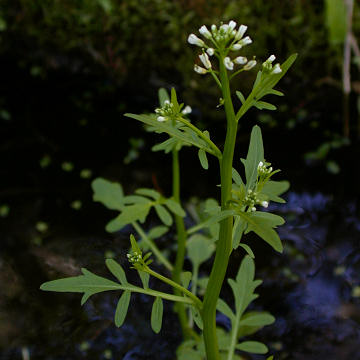

Cardamine pensylvanica - (image 1 of 5)
Taxonomy
Family: Brassicaceae
Habitat
Wet woods and swamps.
Associates
Distribution
Newfoundland and Quebec west to MN and British Columbia, south to FL and CA.
Morphology
Herbaceous annual or biennial to 60 cm; stems erect or spreading, usually hispidulous at least below, rarely glabrous. Terminal leaflet of of basal leaves obovate to orbicular, to 2 cm wide; cauline leaves typically 4-8 cm, the terminal segment cuneate-obovate, the lateral of shallower, smaller lobes. Flowers on ascending pedicels; petals white, to 4 mm. Fruit ascending, 2-3 cm, the style forming a beak 0.5-2 mm.
Notes
Flowers late April to June, sporadically into the fall
Wetland indicator: Obligate
Edible. Similar to watercress. Smaller plants found in drier habitats begin to resemble C. parviflora L.
References
Gleason, Henry A. and A. Cronquist. 1991. Manual of Vascular Plants of
Northeastern United States and Adjacent Canada. Second Ed.
The New York Botanical Garden. Bronx, NY
Peterson, L. A. 1977. A Field Guide to Edible Wild Plants: Eastern and central
North America
Houghton Mifflin Company. New York, NY
Swink, F. and G. Wilhelm. 1994. Plants of the Chicago Region. Indiana Academy of
Science.
The Morton Arboretum. Lisle, Illinois.
USDA, NRCS. 2002. The PLANTS Database, Version 3.5 (http://plants.usda.gov).
National Plant Data Center, Baton Rouge, LA 70874-4490 USA.
|
Michael Hough © 2004 |